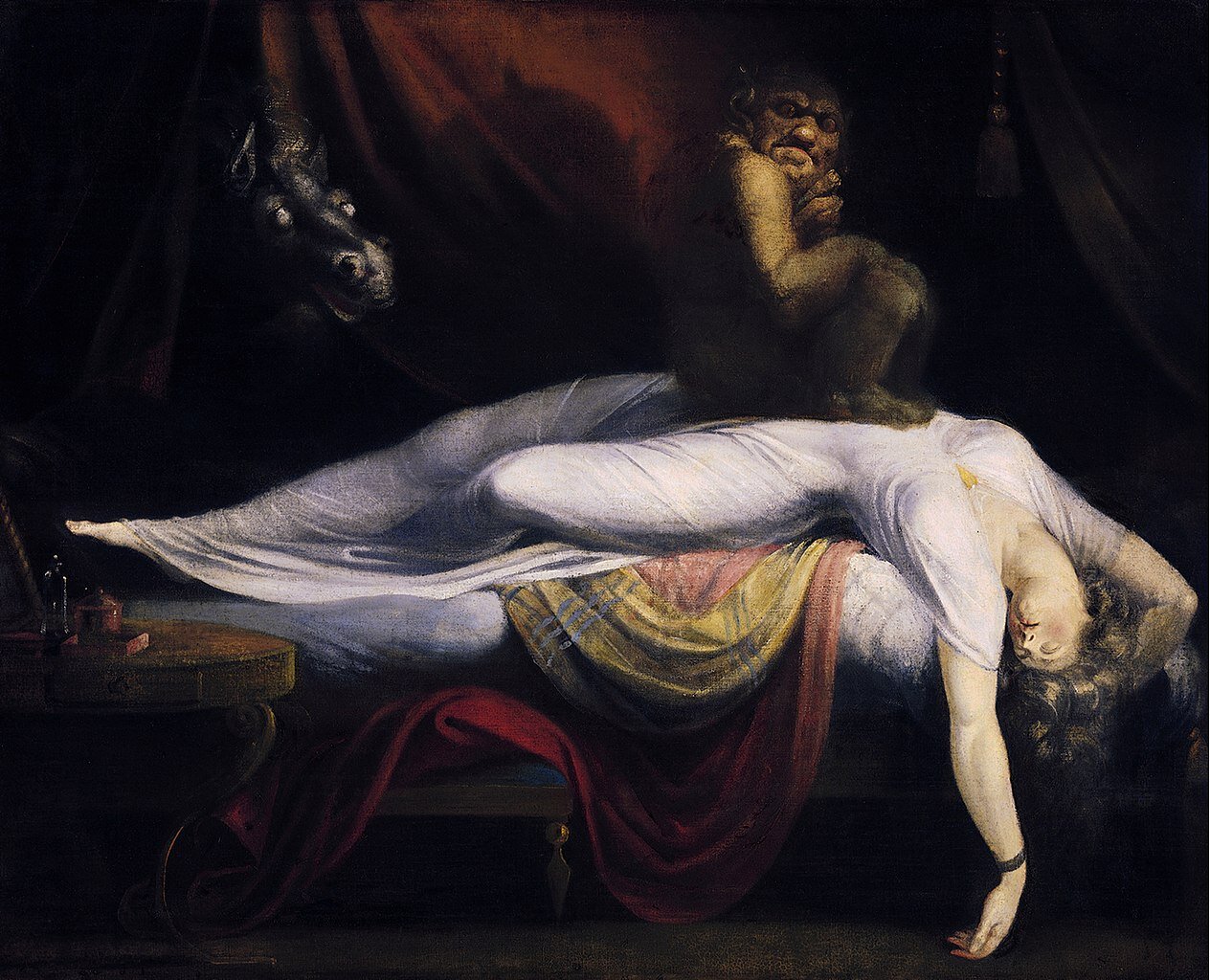17 June 2021
If you’ve ever played Dungeons and Dragons, or perused its Monster Manual, you may have encountered the description of a nightmare. The Forgotten Realms Wiki, which is about the role-playing game, describes nightmares thusly:
Nightmares were seemingly emaciated stallions, approximately 6 feet (1.8 meters) tall at the shoulders, with night-black coats. On further examination, however, their warhorse-like exterior was revealed to be entirely superficial. They had huge heads, fangs like vipers, and malevolent dark eyes often illuminated by red-hot flames, and they spouted orange fire when their nostrils flared. Wreathed in fire, their manes were wild and their tails unkempt, but they turned to cinders and quickly dispersed upon death.
It’s understandable that a speaker of Present-Day English would think a nightmare was some kind of demonic horse, but outside of D&D that’s not the case.
Of course, in Present-Day English a nightmare is a scary dream. The word dates back to Old English and is a compound of niht (night) + mære (demon, evil spirit), in other words an incubus or succubus. These demons supposedly visit humans in the night and have sexual relations with them, causing erotic dreams, inspiring lustful thoughts, and doing worse things. Incubi are male demons, succubi female. Mære (demon) is not to be confused with mearh (horse), which gives us the present-day mare, a female horse. (And since I’ve brought D&D into the discussion, I might as well mention that readers of Tolkien’s Lord of the Rings have probably recognized that this latter word was the inspiration for the mearas, the bloodline of horses in the novel that produced Gandalf’s horse Shadowfax.)
We see mære (demon) in the late seventh-century Épinal Glossary, a Latin-Old English lexicon:
incuba mera uel satyrus
And we see a fuller description in the ninth-century Bald’s Leechbook, a medical text:
Gif mon mare ride genim elehtran & garleac & betonican & recels, bind on næsce, hæbbe him mon on & he gange in on þas wyrte.
(If a mare ride a man, take lupins & garlic & betony & frankincense, bind them in a fawn’s skin, let him have the worts on [him], & let him go on [his way].)
The compound nightmare appeared by the end of the thirteenth century. We see it in the South English Legendary, a collection of hagiographies or saints’ lives. In that collection, the story of St. Michael the Archangel includes a description of demons, including the nightmare:
Þe luþere gostes beoth a-boute with heore luþere pouwer
To bi-traye wrechche men and bringue into heore paunter;
And þe guode beoth al-so a-boute with power þat heore is
For-to witien men fram sunne þat huy ne wurchen amis.
Boþe þe luþere and þe guode a-liȝteth ofte a-doun
And to men in hore slepe comieth ase In a visioun
And scheowieth in metingue mani a wounder dede,
Þe guode of guode þinges and þe luþere euere of quede,
And deriez men in heore slep and bodieth seoruwe and care,
And ofte huy ouer-liggez [men] and men cleopiet þe niȝt-mare.(The wicked spirits are about with their wicked power to betray wretched men and bring [them[ into their snare; and the good [spirits] are also about with the power that there is to protect men from sin so that they not behave amiss. Both the wicked and the guode [spirits] often alight down and come to men in their sleep as in a vision and show in dreams many a wondrous deed, the good of good things and the wicked always of sinful [things], and injure men in their sleep and bode sorrow and care, and often overlie [men] and men call them nightmares.)
The demonic mære largely fell out of use in the Early Modern period, only persisting in some regional dialects, hence the confusion and semantic substitution of a horse for the demon.
Sources:
Cockayne, Oswald, ed. Leechdoms, Wortcunning, and Starcraft of Early England, vol. 2 of 3. London: Longman, et al, 1865. 140. Google Books.
Horstman, Carl, ed. The Early South-English Legendary. Early English Text Society, OS 87. London: N. Trübner, 1887, 306. HathiTrust Digital Archive. Oxford, Bodleian Library, MS Laud Misc 108, fol. 134v.
Middle English Dictionary, 2019, s.v. night-mare, n., mare, n.(2).
“Nightmare (Creature).” Forgotten Realms Wiki, 5 April 2021.
Oxford English Dictionary, third edition, December 2020, s.v. nightmare, n. and adj., mare, n.2.
Pheifer, J.D. Old English Glosses in the Épinal–Erfurt Glossary. Oxford: Clarendon Press, 1974, 30. HathiTrust Digital Archive. Épinal (Vosges), Bibliothèque Municipale MS 72(2).
Image credits: Henry Fuseli, 1781, The Nightmare, oil on canvas, Detroit Institute of Arts, public domain image. Anonymous scribe, late thirteenth century, Oxford, Bodleian Library, MS Laud Misc 108, fol. 134v, Bodleian Library, Oxford University, used under a Creative Commons Attribution-NonCommercial 4.0 International (CC BY-NC 4.0) license.


